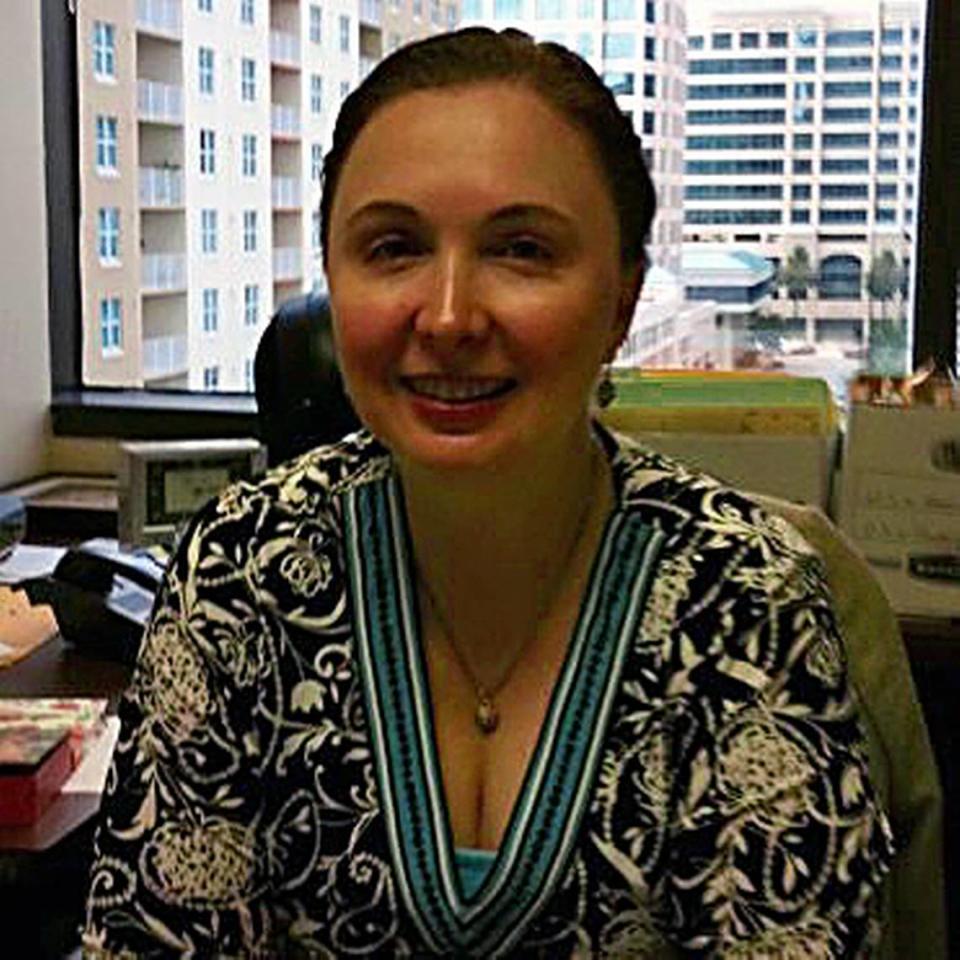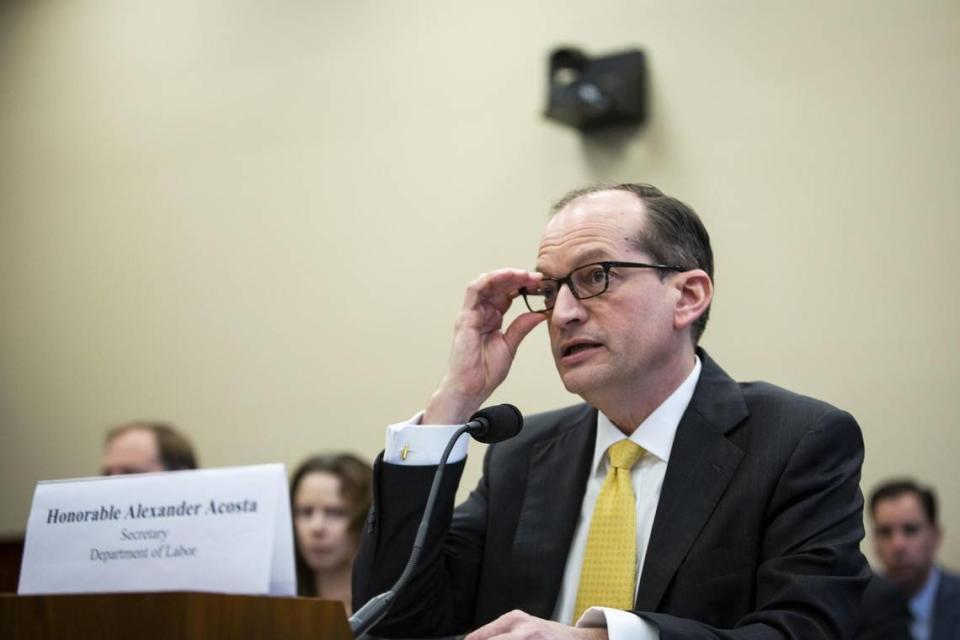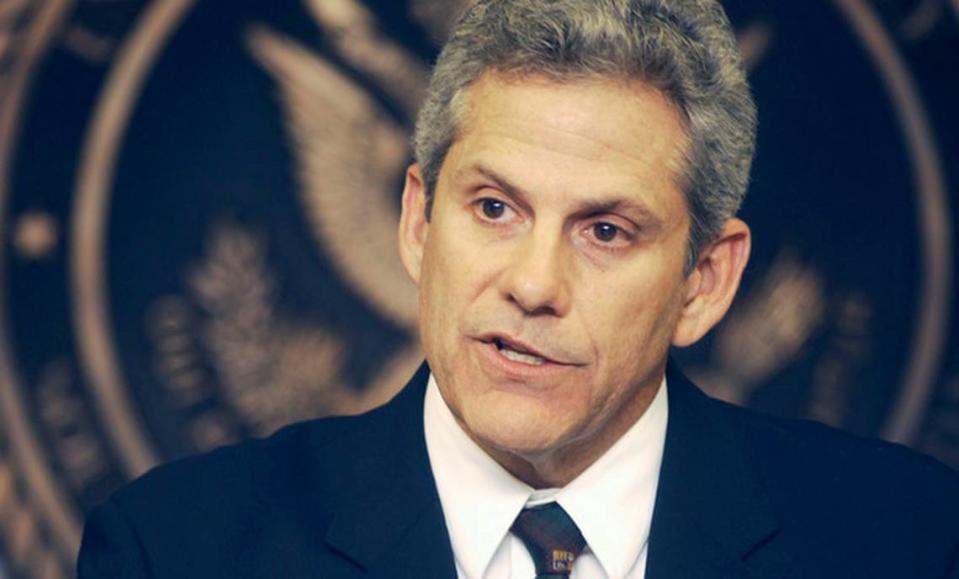This prosecutor tried to put Epstein away for decades. Powerful men maneuvered to stop her
When Jeffrey Epstein pleaded guilty in state court in June 2008 to two sex solicitation charges, which came with an 18-month sentence but avoided tougher federal sex-crimes charges as part of a deal with the feds, colleagues of the federal prosecutor who had led the investigation flooded her with congratulations.
But Ann Marie Villafaña was in no mood to celebrate.
“After all the hell they put me through, I don’t feel like celebrating 18 months,” Villafaña wrote to one colleague about Epstein’s sentence, which became a #metoo symbol of how rich and powerful sex offenders can evade justice. “He should be spending 18 years in jail.”
That’s according to a look-back report from the Justice Department’s Office of Professional Responsibility (OPR). A summary of the report was issued last week. The fuller document, provided to members of Congress, who requested the inquiry, was obtained by the Miami Herald and its parent McClatchy.

In the end, Epstein served only 13 months, not 18 — and not in the jail but in the cushier confines of the Palm Beach County stockade. He was afforded his own wing to protect the Palm Beach multimillionaire from extortion. And thanks in part to a decision by Palm Beach County Sheriff Ric Bradshaw that Epstein need not register as a sex offender until after he had served his time, Epstein, a man accused of sexual abuse by dozens of girls, was able to qualify for work release. He would be whisked away from the stockade by a chauffeur — for 12 hours a day, six days a week — guarded by Bradshaw’s deputies, working paid off-duty shifts.
The deal was largely forgotten in November 2018 when the Miami Herald published Perversion of Justice, an investigative project dissecting the so-called federal “non-prosecution agreement” (NPA). In the series’ aftermath, Epstein was arrested by the U.S. attorney in Manhattan on sex trafficking charges. Weeks later, he was found hanging by the neck in his New York City cell while awaiting trial, a death that was called a suicide. The U.S. attorney who had explicitly blessed the original deal, Alexander Acosta, resigned his post as President Donald Trump’s secretary of labor.
Villafaña, who remained on the job with the U.S. attorney, left last year to join the Department of Health and Human Services.

The OPR investigation was a chance for Villafaña to have her say after years of silence amid reports that she was the line prosecutor on a case that many considered a gross injustice.
The full report, 350 pages long, finds no official misconduct by the Justice Department or then-U.S. Attorney Acosta, but merely myriad examples of poor judgment, both in the way Acosta allowed the case to be disposed of and the way victims were misled to believe it was still under serious investigation. And it describes how the determined efforts of Villafaña were thwarted by an all-star cast of prominent defense lawyers, the county sheriff who granted Epstein work release, and, in Villafaña’s view, her own less-than-supportive superiors, Acosta among them.
“Ms. Villafaña believes the injustice in this case is a direct result of implicit biases based on gender and socioeconomic status — biases that allowed Mr. Epstein’s defense team unparalleled access to the decision-makers at the Justice Department, while the victims, Ms. Villafaña, and the FBI agents working the case were silenced,” said a statement to the Miami Herald from Ty Kelly, Villafaña’s lawyer during the Justice Department review.
While Villafaña had vivid memories of nearly everything that occurred, Acosta told OPR he had no recollection of an Oct. 12, 2007, breakfast meeting he held with one of Epstein’s top lawyers at the West Palm Beach Marriott. Perversion of Justice called it a pivotal moment during which a controversial non-prosecution agreement was consummated. The OPR review stated it “did not find evidence establishing” that this was the case and noted that a draft of the federal NPA — which would include not only Epstein, but his assistants and any other unnamed individuals implicated — had already been signed by Epstein. But discussions of a critical addendum to that draft took place at the meeting. Afterward, Jay Lefkowitz sent Acosta a note thanking him “for the commitment you made to me during our October 12 meeting in which you promised genuine finality with regard to this matter … .”
Although it was her case, Villafaña wasn’t present for the breakfast meeting.
Nearly all those who put Villafaña through “hell” as she sought to bring an abuser of young girls to justice shared a singular characteristic. They were men, a dynamic that takes on added meaning in the wake of the overdue arrests of Bill Cosby and Harvey Weinstein and the advent of the #metoo movement, which zeroed in on gender and power inequities.
The report, in dismissing any actual misconduct, says U.S. attorneys have broad discretion, absent “corruption or other impermissible considerations” to prosecute or not.
The report says that Villafaña learned of Epstein’s abuses from an FBI case agent who told of a Palm Beach detective who was concerned that the state attorney’s office was trying to minimize or bury the abuses because of Epstein’s local prominence. On July 14, 2006, she met in person with Acosta and Jeffrey Sloman, who at the time was head of the criminal division but soon afterward became Acosta’s top deputy, to inform them about the case. She said she was not discouraged from proceeding. (Sloman and Acosta both told OPR they had no recollection of the meeting.)
“I remember specifically saying to them that I expected the case would be time- and resource-intensive and I did not want to invest the time and the FBI’s resources if the Office would just back down to pressure at the end,” Villafaña told OPR.
Later in July 2006, after a state grand jury indicted Epstein on minor charges, Villafaña felt the detective’s concerns about a whitewash were validated and she pressed ahead with her investigation.
In the fall of 2006 and throughout early 2007, Epstein’s lawyers, by now aware of the federal investigation, pressed for a meeting with prosecutors. Villafaña responded that she first wanted the Epstein team to provide more documents pertinent to the investigation. One of her specific concerns was that when local authorities conducted a search of Epstein’s palatial estate on the Palm Beach waterfront, where he allegedly had underage girls massage him and engage in sex acts, computer drives and other equipment connected to omnipresent surveillance cameras were missing and it appeared as if he had been tipped off to the raid in advance.
It was said that Epstein liked to retain photos and videos of his victims and his home was bristling with cameras.
Rather than provide the documents and other evidence, Epstein’s team went over Villafaña’s head. A meeting was scheduled. Villafaña was in the room. The Epstein attorneys brought along a 25-page letter attacking the credibility of Epstein’s young accusers as liars and drug users.

On May 1, 2007, Villafaña drafted an 82-page prosecution memo directed to Acosta, Sloman and his successor at the criminal division, Matthew Menchel, supporting a proposed 60-count indictment. Weeks later the Justice Department division that combats child exploitation reviewed her materials, offered to work with her and called the memo “exhaustive” and “well done.”
Acosta would tell OPR investigators he could not recall ever reading the document, and that he relied on others for such things. In a statement last week, he said the OPR report “vindicates” the decisions he and underlings took.
The OPR report describes how Villafaña became angry in July of that year when Menchel explained to her in an email that he had proposed to Epstein lawyer Lilly Sanchez, one of the few women involved in the case, that the federal prosecution Villafaña was working on be resolved with a plea deal in the parallel state case. Villafaña felt it was an end-run around her.
“[I]t is inappropriate for you to enter into plea negotiations without consulting with me or the investigative agencies, and it is more inappropriate to make a plea offer that you know is completely unacceptable to the FBI, ICE [Immigration and Customs Enforcement], the victims and me,” she wrote.
Villafaña, who worked in West Palm Beach, sought a meeting with the Miami-based Acosta and Sloman.
As the OPR report went on to state: “Menchel’s reply began with a rebuke.”
“Both the tone and substance of your email are totally inappropriate,” he wrote.
He went on: “If the U.S. Attorney [Acosta] or the First Assistant [Sloman] desire to meet with you, they will let you know. Nor will I direct Epstein’s lawyers to communicate only with you,” wrote Menchel. “If you want to work major cases in the district you must understand and accept the fact that there is a chain of command — something you disregard with great regularity.”
He would add: “As you well knew, you were never given authorization by anyone to seek an indictment in this case.”
Years later, Villafaña would tell OPR investigators the email was “meant to intimidate” and that she felt “put in [her] place.”
In her interview with the internal investigators, Villafaña explained her view that Epstein’s legal team was out to steamroll the U.S. attorney’s office.
Villafaña said Acosta “was influenced by the stature of Epstein’s attorneys.” The high-priced legal team included Lefkowitz, who had been a top lawyer in President George W. Bush’s administration, celebrity attorney Alan Dershowitz, and former Solicitor General Kenneth Starr, who famously investigated President Bill Clinton for his affair with Monica Lewinsky. The team also had multiple former members of the U.S. attorney’s office — including Lilly Sanchez, whom Menchel had briefly dated and whom he was now acknowledged to be negotiating with — and multiple attorneys with the giant law firm Kirkland & Ellis, which previously employed Acosta. (Later, Kirkland & Ellis talked to Acosta about returning to the firm, the report states, leading him to recuse from Epstein matters.)
“I think that the ability of Alan Dershowitz and Ken Starr and Jay Lefkowitz to convince Alex Acosta that I didn’t know what I was talking [about] also, all came into play,” Villafaña told Justice investigators.
Noted Kelly, Villafaña’s lawyer: “The report shows that the entire process authorized by the U.S. Attorney’s office management gave undue weight and credence to the arguments of Epstein’s defense team, who made slanderous and unsupported statements about the victims’ credibility, pushed to disregard facts showing Epstein’s abuse of girls as young as 14, and made the outrageous and unprecedented assertion that there was no federal interest in the actions of a man flying interstate to engage in sexual activity with children.”
Two weeks after submitting her prosecution memorandum, on May 14, 2007, Villafaña wanted to take the next step. In an email, she told Menchel that Epstein was flying to New Jersey from the Virgin Islands and she asked whether she could file charges the next day.
In his email response, Menchel tapped the brakes. “This is obviously a very significant case and [A]lex wants to take his time making sure he is comfortable before proceeding.” (The OPR report notes Menchel’s previous relationship with Sanchez and that he neglected to tell that to Acosta of the potential conflict.)
As to why the urgency, Villafaña would tell the OPR investigators: “because child sex offenders don’t stop until they are behind bars.”
Acosta would never proceed with a prosecution, deciding instead to use the non-prosecution agreement as a vehicle to send the case back to the state attorney with a predetermined outcome: a guilty plea to minor charges. Acosta would explain that he feared he might lose if the case went to trial, leaving Epstein unpunished. The plea guaranteed that Epstein would spend some time incarcerated and that he would have to register with the state as a sex offender, both of which Acosta considered important.
Initially, the plan called for Epstein to serve a two-year term, a provision on which Villafaña — who believed Epstein deserved “dozens” of years — was “not consulted,” she told OPR investigators. Twenty-four months was then whittled down to 20 months and then to 18 months. The OPR report says the evidence it collected “doesn’t clearly show why” these reductions were implemented.
After Epstein’s formal guilty plea on June 30, 2008, the 18 months quickly became 13.
On Oct. 10, 2008, the Palm Beach sheriff placed Epstein on work release so he could spend his days at something called the “Florida Science Foundation.” As a practical matter, that meant he could hang out at the office of another of his lawyers, Jack Goldberger, which doubled as the nominal headquarters of the Florida Science Foundation, something Epstein created.
The U.S. attorney’s office wasn’t informed of the work release arrangement. In mid-November 2008, Villafaña learned Epstein was on the loose 12 hours a day. Stunned, Villafaña wrote to Roy Black, still another member of Epstein’s legal team, calling work release a “material breach” of the NPA. Black forwarded his response to Villafana’s superior, Sloman, complaining that Villafaña “is very concerned about anything that Epstein does.”
Around then, the report shows, she fired off an angry memo to Acosta and Sloman.
“Can I indict him now?” she asked.

